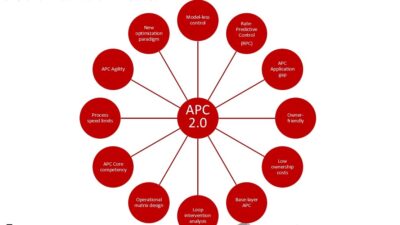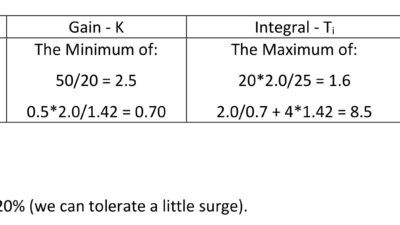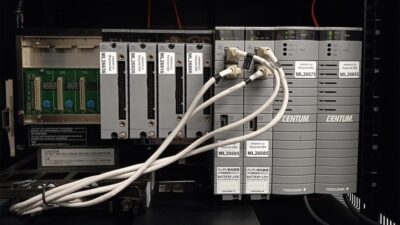When there is too much air in the combustion process, additional fuel is burned to raise the temperature of this excess air to that of the combustion process. Excess air is a costly waste of fuel because it simply absorbs heat that goes up the stack, rather than into the process. How does one guard against these problems? If there is not enough air being introduced into the combustion process, ...
AT A GLANCE
Stoichiometric combustion
CO vs. O 2 control
Air-to-fuel ratio
Operator setpoint changes
When there is too much air in the combustion process, additional fuel is burned to raise the temperature of this excess air to that of the combustion process. Excess air is a costly waste of fuel because it simply absorbs heat that goes up the stack, rather than into the process.
How does one guard against these problems?
If there is not enough air being introduced into the combustion process, all fuel will not be burned and, consequently, it will be lost up the stack in the form of combustibles. Not only does this result in an obvious waste of valuable energy, safety and pollution hazards are created. For each increment of change, the energy lost due to excess CO in the flue gas is five- to ten-times greater than the energy required to heat the excess air. To avoid this condition, there is a natural tendency by operators to introduce excess air into the furnace.
The proper condition of stoichiometric combustion, where only enough air is supplied for complete oxidation of each hydrogen and carbon atom from the fuel, is extremely difficult to maintain. This condition can best be approximated by starving the combustion air until some carbon atoms cannot continuously get enough oxygen in the combustion (radiant) section of the furnace, and CO is formed instead of CO 2 . This is the basis of the technology known as low excess air CO-based control.
Combustion control
This technology is now being promulgated throughout large fuel gas users to operate the combustion process with furnace O 2 levels in the fractional range, typically from 0.5% to 1%.
The specific gravity—and thus the BTU content—of the fuel will vary from typically 700 BTU per standard cubic foot to twice that. In some cases, plant residual oil is used as fuel, usually in combination with gas. Unique to refineries and chemical plants is the possibility of a rapid and unannounced change of fuel composition due to upsets in different refinery units causing dumping of product in the fuel system.
To achieve long-lasting results, this technology needs to encompass three distinct components: CO light beam analyzer; Control strategy; and Combustion education.
Accomplishing long-term operation with CO-based control requires all three.
CO light beam analyzer
The first necessary component is a highly reliabile primary sensor. The sensing element and analyzer needs to be specific to CO in the typically severe environmental conditions of the refinery or plant. With liquid fuels being fired in addition to gas fuel, opacity needs to be continuously measured for incorporation into the control strategy.
This fast-light-beam-type sensor should:
Measure all flue gas;
Be unaffected by air leaks;
Have high discrimination; and
Show simple, believable calibration.
Without instrumentation acceptable to operators, efficient low excess air firing will not remain implemented, operations will lose interest, and the instrumentation will become downgraded to a monitoring device. Maintenance and calibrations will then be compromised and soon the analyzer will be inoperable.
Because O2 is only an approximation of the burning condition, controlling CO instead limits combustibles from exiting the stack and helps maintaining a safer operation.
CO analysis avoids the inaccuracies and time lag of sampling systems and does not require hardware in the stack, specific purging, or zeroing procedures.
Control strategy
As with any project, properly designed controls are a necessity for long-term implementation.
Each heater or boiler requires a unique control strategy. These strategies should be designed for the application and need to seamlessly interface and interact with existing controls. CO-based control requires a very fast controller with features beyond classic O 2 control.
A primary failure in having CO-based control systems remain in operation over the long term involves adapting the CO process variable to a classic O 2 control without the unique changes CO requires. The control system must be designed to deal with the heater- or boiler-specific conditions. Individualized operating constraint conditions and setup parameters must be designed and incorporated, including:
Firing rate variations;
Frequency of fuel BTU changes;
Shutdown and low fire duty;
Cutting burners;
NO x emissions limits;
CO emissions limits;
Bridge-wall temperature limits;
Tube skin temperature limits;
Existing O 2 alarms; and
Alarm conditions responses.
The system automatically and continuously adjusts the air supply so the optimal fuel-to-air ratio is maintained at all times and under load-varying conditions. In addition, there is automatic compensation for fluctuations in fuel viscosity or BTU content, draft irregularities, changes in air density, load, temperature, humidity, and looseness in the damper and fuel valves.
Process lag time and deadbands in the existing controls need to be incorporated in such control algorithms.
Direct CO-based control allows precise action to be taken in adjusting the air-to-fuel ratio and is accomplished without switching between CO and O 2 . Feed-forward load signals are utilized for anticipating combustion upsets, and predictive control compensates for process lag time, which prevents potential smoking problems.
The effect of CO-based control on O2 and NOx levels can be seen in this graph, which shows O2 dropping between 3% and 4% and NOx dropping 5 to 6 ppm from levels achievable without CO-based control.
Combustion education
Equally important for CO-based low excess air control is ‘combustion engineering.’ This encompasses a complete training of the concept and operation of the heater or boiler with the CO-based control. In the combustion arena, this is equivalent to the complete culture change industry experienced upon the advent of digital control and DCS.
Combustion engineering training centers on:
Balancing burner combustion;
Identification of dirty burners;
Incorrectly adjusted burner air registers;
Poor burner atomization;
Placement of O 2 analyzer;
Placement of furnace draft analyzer;
Air leaks in the furnace; and
Fuel leaks in the firebox.
Operators can secure about half of the expected efficiency gains of low-excess-air firing by manually tuning the fired equipment. Basic tune-up is accomplished with a well-designed automatic CO-based control system.
CO- and O2-based control
While it may seem convenient to have O 2 as well as CO in the control loop, it is not necessary or preferred. See ‘CO vs. O 2 vs. NO x relationship’ graphic.
CO provides the measurement directly related to combustion completeness and can be best used in the exact control of the fuel burning process.
O 2 is only an approximation of the burning condition. By controlling CO, the control system is inherently limiting combustibles from exiting the stack, thereby maintaining a safer operation.
Operator changes of control set points are not needed upon variations in fuel or load with CO control. O 2 control requires operator attention, which results in a bias added to the excess air setting to cover these conditions during normal operation.
CO is measured completely across the stack to give an accurate representative analysis of the stack gas. Probe-type measurements, especially when mounted before any mixing of the flue gas, become subject to the errors of stratified burner conditions.
Air leakage prior to measurement affects CO as direct dilution and has no appreciable influence on its use in control. O 2 is then unable to be useful as a control parameter if air infiltration exists before the probe.
Author Information
Robert J. Bambeck is president and CEO of Bambeck Systems Inc., Santa Ana, CA;



